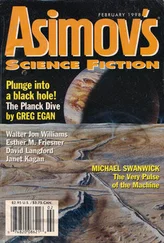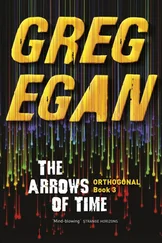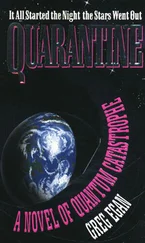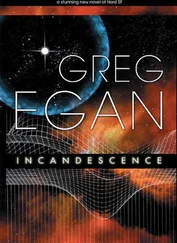Greg Egan - The Clockwork Rocket
Здесь есть возможность читать онлайн «Greg Egan - The Clockwork Rocket» весь текст электронной книги совершенно бесплатно (целиком полную версию без сокращений). В некоторых случаях можно слушать аудио, скачать через торрент в формате fb2 и присутствует краткое содержание. Жанр: Фантастика и фэнтези, на английском языке. Описание произведения, (предисловие) а так же отзывы посетителей доступны на портале библиотеки ЛибКат.
- Название:The Clockwork Rocket
- Автор:
- Жанр:
- Год:неизвестен
- ISBN:нет данных
- Рейтинг книги:3 / 5. Голосов: 1
-
Избранное:Добавить в избранное
- Отзывы:
-
Ваша оценка:
- 60
- 1
- 2
- 3
- 4
- 5
The Clockwork Rocket: краткое содержание, описание и аннотация
Предлагаем к чтению аннотацию, описание, краткое содержание или предисловие (зависит от того, что написал сам автор книги «The Clockwork Rocket»). Если вы не нашли необходимую информацию о книге — напишите в комментариях, мы постараемся отыскать её.
The Clockwork Rocket — читать онлайн бесплатно полную книгу (весь текст) целиком
Ниже представлен текст книги, разбитый по страницам. Система сохранения места последней прочитанной страницы, позволяет с удобством читать онлайн бесплатно книгу «The Clockwork Rocket», без необходимости каждый раз заново искать на чём Вы остановились. Поставьте закладку, и сможете в любой момент перейти на страницу, на которой закончили чтение.
Интервал:
Закладка:
She bounded up the stairs and ducked into the markets to buy a loaf, then made it out onto the street in time to see the stars before the pale sky extinguished them completely. In Zeugma, only the wealthiest inhabitants with their private, walled gardens had the choice of sleeping in the open air; if you dug an indentation beside the flowers in the parks you were beaten for damaging city property. But Yalda preferred to spend her nights beneath the markets rather than waste money on an apartment in the towers, where your bed was cooled by a thermal conduit of calmstone columns, buried in the ground but stretching up to drain the heat from the highest of those dreary cages.
She still had five chimes before her appointment with Eusebio, but she wanted to be thoroughly prepared in order to ensure that the session didn’t run over time; there was a mid-morning lecture by a visiting scientist on new developments in optics that she didn’t want to miss. So she paced the grimy streets between the markets and the university, planning her lesson in detail, composing diagrams as she walked. There weren’t many pedestrians about, and in any case the people she passed showed no surprise at the strange shapes forming and shifting on her skin. Some academics went to great pains to conceal their priceless musings, learning to make purely mental sketches or to ensure that anything showing on their body was at least writ small on the palms of their hands, but Yalda had never felt the need to cultivate those furtive habits.
She had timed her peregrinations perfectly; the university clock made its doleful noise just as she entered the stone tower where Eusebio lived. Yalda took the stairs quickly; to arrive right on the chimes would have been ill-mannered, but a sprint to the fourth floor would be enough to take the edge off her punctuality.
When she reached the apartment the curtained entrance was already parted to welcome her; she called out “It’s Yalda!” and stepped through. The room smelled of dye and paper; there were dozens of textbooks stacked against the walls, and Eusebio’s own notes rivaled them in bulk. A merchant’s son hoping to break into the railway business, he took his engineering studies seriously. Even the three small clockwork figurines, marching back and forth beside one pile of books, were evidence of a diversion equally concerned with the subject of what a machine could or could not be made to do.
“Good morning, welcome!” Eusebio was sitting on the floor in the corner, loose pages spread out in front of him. He was bulky for a man, but no less agile for it; Yalda suspected that he’d strived from childhood to match the deftness of smaller peers, much as she had.
She sat facing him, cross-legged, and got straight to the point. She knew exactly what he would have been told in the lecture he’d had the day before; not one word had changed in the introductory physics course since she’d taken it herself, four years previously.
“Conservation of energy and momentum,” she said. “How much did you understand?”
“Maybe half,” he confessed. But Eusebio didn’t claim understanding lightly; Yalda suspected that he’d followed the whole lecture, but longed for a deeper grasp of the subject.
“Let’s start with something simple,” she suggested. “Suppose an object is free to move, without friction. It starts out at rest, and you apply a constant force to it. After some time has passed, tell me how the force, the time, and the object’s velocity are related.”
Eusebio said, “Force equals mass times acceleration; acceleration by time gives velocity. So, the product of force and time equals the product of the object’s mass and its velocity—also known as its ‘momentum’.”
Yalda widened her eyes approvingly. “And in the general situation, where the object need not start from rest? The product of the force and the time for which it’s applied gives…?”
“The change in the object’s momentum.” Eusebio lifted a sheet of calculations. “I confirmed that.”
“Good. So, if two objects interact—if a child throws a stone at an approaching train, and it bounces off the front carriage—what happens to their momenta?”
“The force of the train on the stone is equal and opposite to the force of the stone on the train,” Eusebio replied. “And since both forces act for the same amount of time, they cause equal and opposite changes of momenta: as much as the stone’s momentum rises—measured in the direction of the train’s motion—the train’s will fall.”
Yalda said, “So the total, the sum of the two, is unchanged. What could be simpler?”
“Momentum is simple enough,” Eusebio agreed. “But energy—”
“Energy is almost the same!” Yalda assured him. “It’s just that instead of the product of force and time, you use the product of force and distance traveled. What’s an easy way to turn the first into the second?”
Eusebio thought for a moment. “Multiply it by distance over time, which is the average velocity . For an object that started from rest and accelerated smoothly, that’s half the final velocity it’s reached. So the product of the force and the distance traveled is the product of momentum and half the velocity… or half the mass times the velocity squared. The kinetic energy.”
“Exactly,” Yalda said.
Eusebio understood these calculations well enough, but he was less happy with the bigger picture. “Energy is where the ‘conservation laws’ start to sound more like a long list of exceptions,” he complained.
“Maybe. Tell me about the exceptions.”
“Gravity! Drop a book from my window; its kinetic energy certainly won’t stay the same. And the fact that the book pulls the world up toward it with as much force as the world pulls it down doesn’t help; that keeps momentum balanced, but not kinetic energy.”
“Sure.” Yalda brought one of the diagrams she’d rehearsed onto her chest.
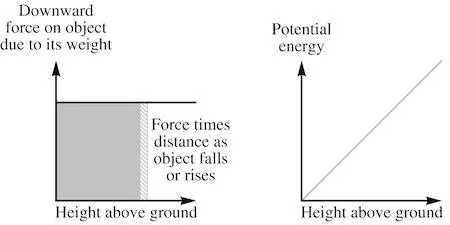
“If you plot the downward force on the book against its height above the ground,” she said, “it’s a constant, a flat, straight line. Now think about the area under that line , up to the point representing the book’s current height. When the book falls, the reduction in the area—the little rectangle that gets chopped off—will equal the force on the book times the distance it travels—which is precisely the amount by which its kinetic energy increases: force times distance.”
Eusebio examined the diagram. “All right.”
“Alternatively, if the book is tossed upward and gravity starts to slow its fall, it will be losing kinetic energy… but the area under the line will increase in a way that precisely balances the loss. So, we call this area ‘potential energy’, and the sum of the two kinds of energy, kinetic and potential, will be conserved.
“This works for other simple forces, too—like the force on an object attached to a stretched spring.”
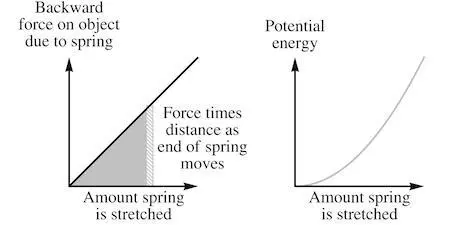
Eusebio said, “I understand why the mathematics works out as you’ve described it. But isn’t this just a fancy way of saying: kinetic energy isn’t conserved, it changes… and in a few simple cases we understand the forces responsible, well enough to be able to keep track of the changes?”
“Well, yes,” Yalda agreed. “It’s a kind of accounting. But don’t disparage accounting; it can be a powerful tool. Elastic potential energy can tell you how fast a projectile will fly out of a slingshot; gravitational potential energy can tell you how high that projectile will rise.”
Читать дальшеИнтервал:
Закладка:
Похожие книги на «The Clockwork Rocket»
Представляем Вашему вниманию похожие книги на «The Clockwork Rocket» списком для выбора. Мы отобрали схожую по названию и смыслу литературу в надежде предоставить читателям больше вариантов отыскать новые, интересные, ещё непрочитанные произведения.
Обсуждение, отзывы о книге «The Clockwork Rocket» и просто собственные мнения читателей. Оставьте ваши комментарии, напишите, что Вы думаете о произведении, его смысле или главных героях. Укажите что конкретно понравилось, а что нет, и почему Вы так считаете.


